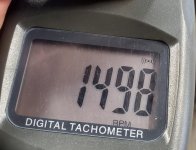......................
I thought 440v was a different kind of power source, not a winding configuration. Is that accurate, or am I off base again?
Gumby
You can have 3 phase at any voltage, but there are standard voltages in the US and slightly different ones in europe etc.
You can have SINGLE phase at any voltage, also. Voltage and number of phases have no definite relation, except for whatever the local standard ones are.
So 440V is just a voltage, might be 3 phase (that's common in the US), or possibly even single phase.
Three phase is the only type circuit associated with a choice of wye or delta. That is a "configuration", and within that there may be configurations of a motor for two (or more) voltages.
Single phase and three phase motors can be made for any voltage. It is most common in the US to have single phase at 120V or 240V, but there is nothing stopping a motor from using 480V single phase. I've used such motors.
Motor voltage:
Motors are designed for a certain voltage per turn of wire inside. The voltage depends on the design of motor.
For any particular motor, the winding configuration for a given voltage is set up to give the right number of turns to handle that voltage. The dataplate typically shows what those are.
When one voltage is double the other one, you need twice the number of turns to handle the higher voltage. To do both voltages, it is usual to have two sets of coils. For the higher voltage, the two sets are in series, so current goes through a coil in set one and the corresponding coil in set two.
For the lower voltage, the coils are in parallel, so half the total current goes through a coil of set one, and the other half goes separately through the corresponding coil in set 2. (Notice that the total current is now double what it was at the higher voltage, just what you expect to get the same power.)
Wye and delta:
A 3 phase motor wired in "wye", aka "star", has each coil wired from one of the three wires to a "neutral point". But that neutral point is rarely if ever connected to a neutral wire. It is a "virtual" neutral, and will have "approximately" the voltage of a real neutral. It works fine even so.
Delta has a coil between 2 of the three wires, call them the "first" and "second". Another is between the second and third, and the last coil is between the third and the first.
In delta, the coils see the nominal line voltage, which is what is between wires.
In wye, the coils are between each of the 3 wires, and a neutral point. Because there are TWO coils in series between any two wires, each coil "sees" less than the full voltage between the wires. Because of the phasing of the voltages in 3 phase (120 degrees apart), they do not each "see" half, they actually "see" about 58% of the voltage between the wires.
So when wired in wye, a coil that is good for 220 volts directly across it, can be used in a 3 phase circuit at 1 / 0.58, or 1.73 times the voltage, which is 380V.
For 220V delta, that comes out to 380V in wye. For 230V, it is 400V, and for 240V it is 415V. That is why those voltages are associated with 3 phase in delta and wye.
Maybe that helps. This stuff is just basic to 3 phase, and you kind of need to automatically think of it in order to understand connections.
Frequency :
The US uses 60 Hz, most (but not all) the rest of the world uses 50 Hz. The frequency affects the usable voltage of a motor.
A motor that is good for 480V at 60 Hz, is good for 5/6 of that voltage at 50 Hz, which is 400V, and will also run at 5/6 the rpm.
And, a motor good for 400V at 50 Hz, is good for 6/5 of that voltage at 60 Hz which is 480V (it will also run at 6/5 of the speed, and the power rating may change a bit).
Some are made to take either frequency at the rated voltage. The motor above is made that way. They still change speed with frequency, though.






